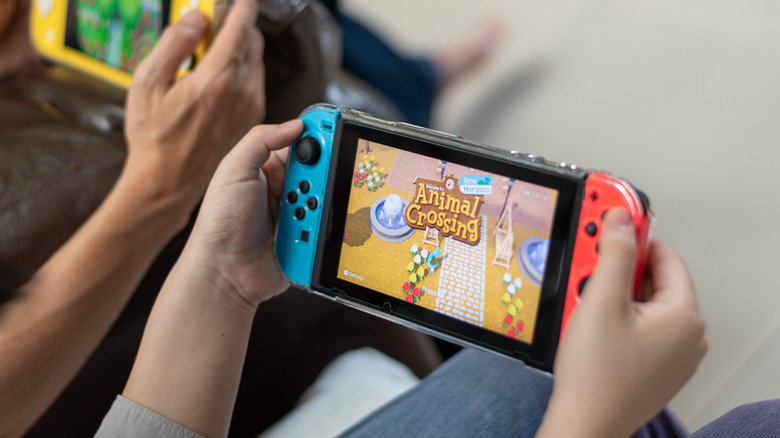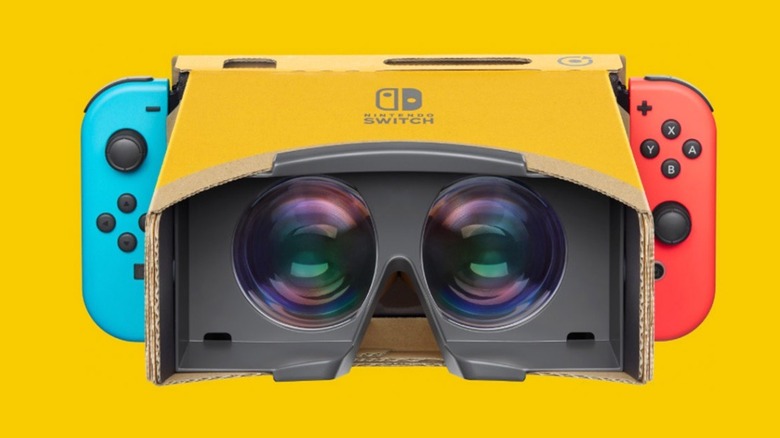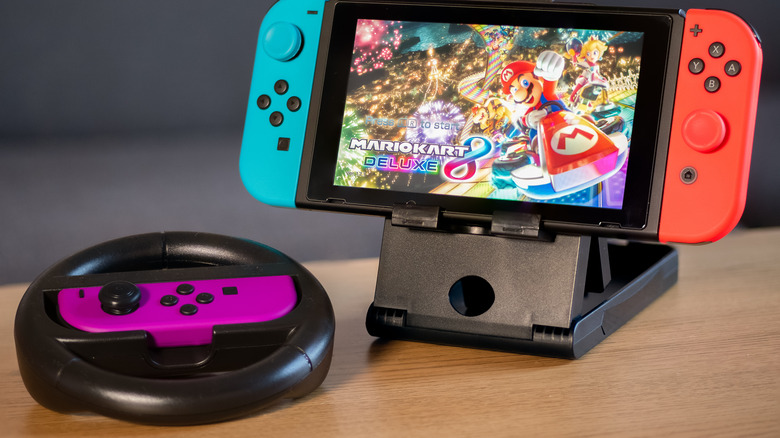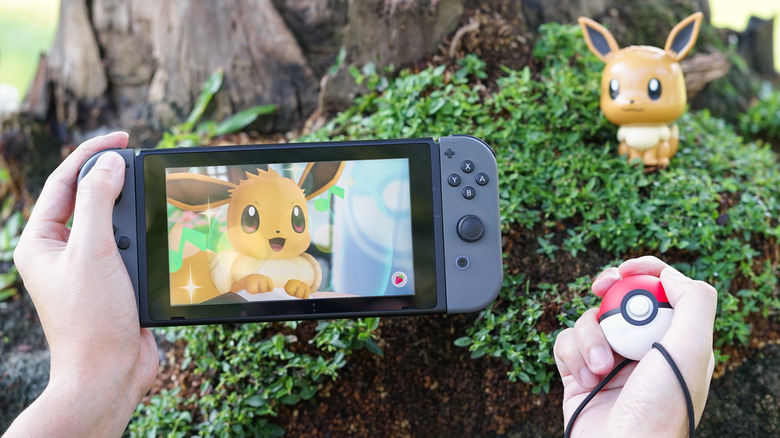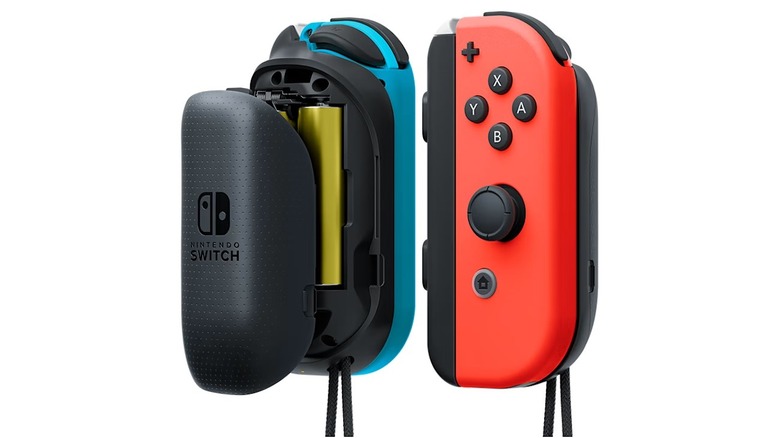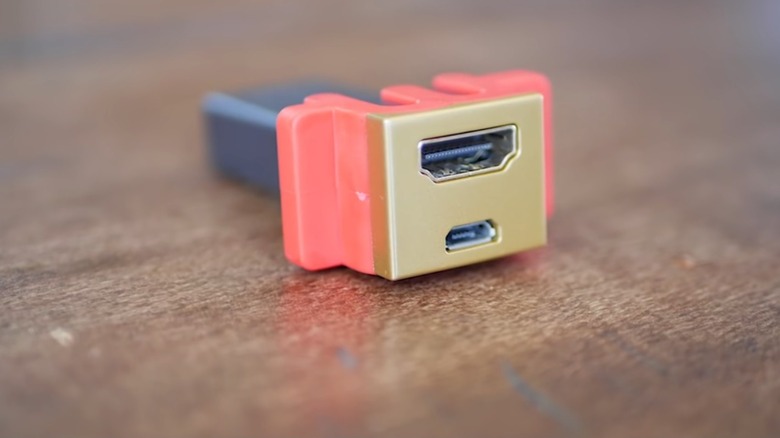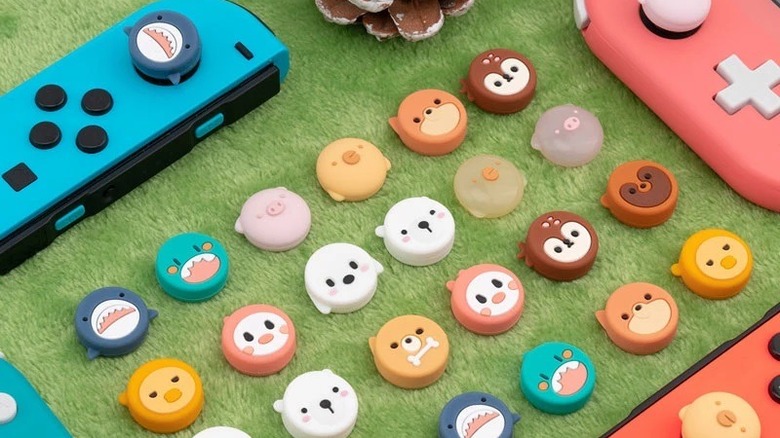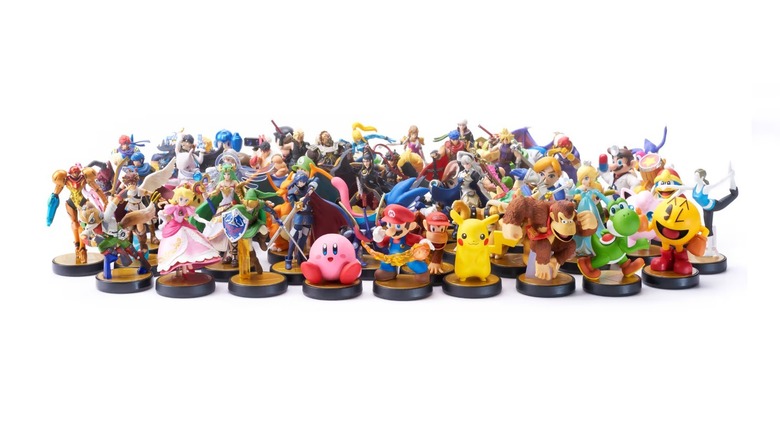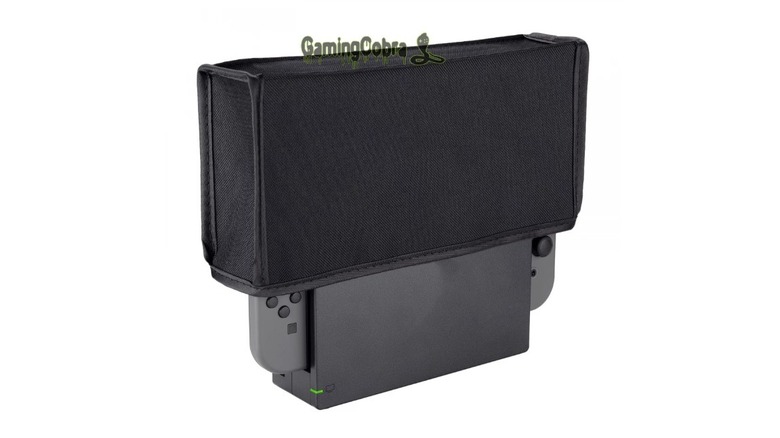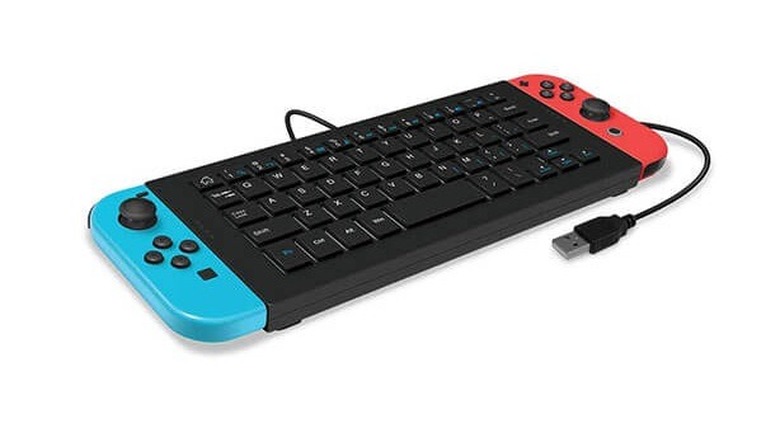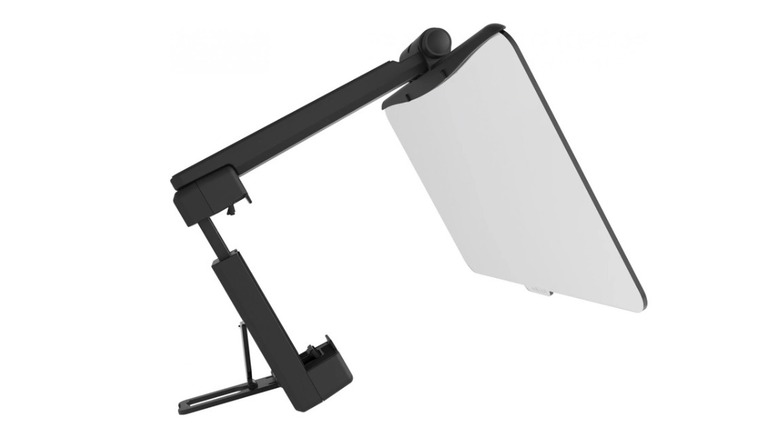Nintendo Switch Accessories That Are A Total Waste Of Money
The Nintendo Switch is one of the most innovative and fun game systems ever created. The fact that you can seamlessly transition it from an at-home console to a handheld gaming device allowed Nintendo to carve out space in both markets. There's a reason it's Nintendo's most successful at-home console to date, and their second most successful console overall, second only to the DS.
Nintendo is known for taking risks, transitioning from their original business model making playing cards to delivering a gaming experience unlike any other, but sometimes that means they miss the mark. Certainly, some Nintendo devices (Virtual Boy, we're looking at you) weren't quite as cool as they might have seemed on the drawing-room table.
The company's commitment to experimentation and innovation has brought us some of the coolest gaming devices in the industry's history. It has also brought us some bizarre accessories and peripherals which would have been better left on the cutting room floor, even in the age of the Switch. That said, Nintendo can't be blamed for all of the missteps; some of those fall squarely at the feet of third-party manufacturers hoping to cash in on the Switch's hype. Before you throw down your hard-earned cash, here are some of the Nintendo Switch accessories you might want to avoid.
LABO
We probably have no one to blame for this one. There's no arguing that Nintendo LABO kits — a collection of cardboard peripherals for use with the Switch — are cool. It's easy to see how they would have made their way from conception to store shelves, and into the hands of consumers. All things considered, they did pretty well for the company, having sold well over a million units by the end of 2018 (via Video Games Chronicle).
Some of the popularity comes from the fact that they work on multiple levels. Once you open the box, you're met with a collection of pieces you have to construct yourself, with the help of onscreen instructions displayed on your Switch or television. It's like having a Lego set you can play games with.
The trouble arises a couple of weeks or months down the line. After you've built and played with your cardboard piano keyboard or fishing rod, they're likely to find a permanent home tucked in a corner of the room. Despite being little more than a few bits of cardboard, you won't want to toss it out because you paid so much for it. Of course, you could spring for the Nintendo LABO cleaning box, which is quite literally a branded cardboard box for storing the rest of your cardboard. LABO isn't bad, per se, you're just unlikely to get much use from it after the figurative sheen wears off.
Nintendo Joy-Con Wheel
At first glance, the Joy-Con Wheel looks like a cool way to add an extra layer of reality to your "Mario Kart" adventures, but the play experience doesn't hold up long enough to make it worth the admittedly low cost. It's essentially a molded piece of plastic within which you can dock a Joy-Con controller. It's marketed as a better, or at least a different, way to play racing games. It ostensibly addresses one of the few shortcomings of the Nintendo Switch's design: the sometimes too-small controllers.
The trouble is, the Wheel isn't much larger. It still feels awkward in the hand, and is moderately uncomfortable to use. Moreover, holding the wheel up in the air, and turning it to change your character's direction, pretty quickly wears on you. Worst of all, the right and left trigger buttons don't always connect well with the buttons on the Joy-Con, which means you don't have total control over when you drift or use weapons. Those are both pretty important components of games like "Mario Kart."
It is a solution to a problem, just not a very good one. The Deluxe Racing Wheel goes some of the way toward correcting the standard Wheel's shortcomings, but there are better ways to careen Yoshi around a corner, and blast your friends and family with blue shells. In the end, it's hard to improve upon the classic "Mario Kart" tactile experience. Just get yourself a master controller.
Poké Ball Plus
When "Pokémon: Let's Go, Pikachu!" and "Let's Go, Eevee!" first dropped, the franchise was experiencing a moment unlike any that had come before. Fans of the series were still riding the collective high of "Pokémon Go," and were willing to do just about anything for cool new ways to catch 'em all.
The Poké Ball Plus controller offered a couple of functionalities that, through the haze of Pokémania, were too much to pass up. Players could use the Poké Ball Plus in place of a regular Joy-Con when playing "Let's Go," but the experience wasn't great. The shape and size of the ball looks cool, but is awkward to use for the full game experience. It's worth mentioning that using it to toss Poké Balls and catch Pokémon in-game is pretty cool, but that's the best thing it has to offer in "Let's Go."
It also has some functionality in "Pokémon Go." You can use it to play without holding your phone by feeling for vibrations, and pressing the button on its face to throw Poké Balls. You can also spin Poké Stops, and earn steps toward hatching eggs. The trouble is you're no longer playing "Pokémon Go" as it was intended, it reduces the game to a Pavlovian set of button presses every time you feel a vibration.
Rather than enhancing gameplay, it strips away some of the things that make these games fun to play in the first place.
Joy-Con Battery Packs
On the surface, an additional battery pack for your Joy-Cons sounds like a great idea. Anyone who remembers the unique pain of playing your Game Boy in the car, and reaching a critical point right as the batteries failed, knows the importance of keeping your system powered up.
The battery packs attach to the back of your Joy-Cons and utilize a pair of AA batteries to deliver supplemental power to the controllers when you need it. Sounds great, right? Then the whole thing falls apart when you remember that Joy-Cons are automatically recharged when docked with the console. Playing with the Joy-Cons docked to the Switch is entirely doable — in fact, the console was designed to operate that way.
Even after years of play, most of us have never encountered a time when external power for our controllers was necessary. Provided you keep the system itself fully charged (if not, the battery packs won't save you), it can give you up to nine hours of playtime before you'll need to find an outlet (via Nintendo). That's more than enough time for all but the longest edge cases. External battery packs for your Joy-Cons are a solution to a problem that doesn't exist.
MClassic Plug and Play Graphics Enhancer
The MClassic graphics processor purports to take the video signal from your Switch and turn it up to 11, giving you an enhanced viewing experience while playing games. To be fair, this plug-and-play HDMI dongle from Marseille does what it says it does, it just isn't all that impressive a user experience most of the time.
The MClassic works by picking up the video signal from your HDMI. It isn't actually doing any of the initial video processing, that's still all happening on the console. Instead, it takes the finished images and runs them through some additional processing to upscale the finished result (via VentureBeat).
There seems to be a sweet spot where the MClassic works best, and that sweet spot is vanishingly small. According to VentureBeat, if your game is already running at 1080p, as many modern games do, then the difference is negligible, and you're unlikely to even notice while playing. At the other end of the spectrum, for vintage 2D games, it doesn't appear to do anything at all.
Even when it is working, the difference in picture is minimal enough that you'd likely have to stop actually playing and toggle the Switch back and forth to notice the difference. That's not exactly conducive to a good gaming experience. Until and unless the effect improves, it isn't worth your time or your money.
Thumbstick Caps
In the realm of worthless Nintendo Switch accessories, thumbstick caps are among the most harmless. They come in a variety of designs, most of which are purely aesthetic in nature and function, allowing you to turn the tops of your Joy-Con analog sticks into "Mario" characters or Pokéballs. There are some which claim to give you a better grip, and improve your ability to play some games. The jury is probably still out on whether or not that's true.
If you like these, there's nothing wrong with getting them, and they often come as part of a package along with a themed Switch carrying case, so you might already have some on hand. The trouble is they're difficult to put on, and they have a tendency to come off over a long enough timeline.
That's especially true if you're playing games that inspire more aggressive handling of your controllers, like the stress-inducing "Celeste." The last thing you want while you're white-knuckling your way through a particularly difficult game stage is for your thumb to slip because your controller's cute little hat fell off.
Amiibo
We're prepared to get more than a little bit of heat for this one, but it's true. Amiibo figures are certainly popular, having sold more than 50 million of the cute little guys as of late 2018, according to a Nintendo financial report. And that number is certain to be significantly higher today.
Amiibo figures and cards offer small bonuses inside a variety of games, ranging from new characters and weapons, to skins or food, all depending on the game you're playing, and the Amiibo you're using. They're one of those accessories that are fun to open and exciting to use, but quickly lose their luster. Unless you're buying a specific figure for a known upgrade in a particular game, they're likely to spend more time on the mantle or in a drawer than in use.
They quickly become one more thing taking up space on the shelf without offering any tangible (or digital) benefit. That said, if you think of them as cool collectibles that can give you a digital bonus when you remember to use them, there's nothing wrong with that. We've certainly purchased toys and figurines which do less.
Dust Cover
This high-quality dust cover promises to protect your Nintendo Switch when it's not in use from the threat of household dust, pet hair, UV light, and more. Simply slot your Switch into its dock, and slide the dust cover over the top to shroud it in darkness and shield it from the various ills of ordinary, everyday life.
Honestly, how dusty is your house, anyway? Presumably, you're playing your Switch every now and again, and it's not locked away in the attic of a haunted Victorian mansion, gathering cobwebs. The cover is hand washable, and you can iron it to maintain its crisply defined edges. It's even waterproof to protect against spills, an unfortunate ceiling leak right over the top of your console, or the inevitable blood dripping from the walls of your enchanted abode.
Perhaps most offensive of all, it just looks silly. Your Switch doesn't need a sleeping bag. Just wipe it off with a cloth if it gets a little dust on it, and you'll be fine. There's absolutely no reason to buy this unless you're taking it on an archaeological dig in an open-top Jeep. Just get a carrying case when you're traveling, and save the gaming for after the tornado has passed.
Keyboard
We get it, sometimes multiplayer video games bring out the worst in us. You've just finished a match, and you're awash in emotions you don't know how to process outside of an unquenchable urge to trash talk your competitors. Yet, for some reason, the console designers have coded an unwieldy typing interface that has you mashing in one character at a time with a toggle and the A button. If only you had a keyboard, then you'd read your online foe for the filth they are.
This third-party wired keyboard has the right tools for the job, offering you the chance to pen a scathing retort just as fast as your little fingers can type. The downside is between responses, you're left to play your game with a nearly full-size keyboard between your Joy-Cons. Not only does it look ridiculous, but it can't be a comfortable way to play.
What's more, it's a cabled accessory, meaning you'll be tethered to your Switch the entire time. Even with 10 feet of leash, you're going to be sitting uncomfortably close to your television with a keyboard in your lap. If you absolutely have to type out your messages, there are better ways. Better yet, just keep your mean comments to yourself.
Screen Magnifier
Picture it: You're playing your Switch in handheld mode, and you're struck with the thought that the game you're playing would be so much better if only the screen were a little bigger. What's an enterprising gamer to do?
Previous iterations of Nintendo's handheld consoles utilized an innovative solution in the screen magnifier. They were clip-on accessories that utilized a magnifying lens to increase the visible size of your display when looking through it. Now, you can duplicate that vintage experience on the Nintendo Switch with this screen magnifier from Qanba.
It's essentially a mount for your Switch attached to an arm holding a Fresnel lens. The specs claim it will double or quadruple your viewing window when peering through it, and it very probably will. However, you won't get any increased detail because physics. All it's doing is blowing up the pixels. That's great if you're having trouble seeing something very small on the screen, but it's likely to make everything look washed out and grainy.
If only there were a better way like, we don't know, docking the Switch to your TV like it was designed to do. The size of your screen is limited only by the size of your wallet. Screen magnifiers made a certain amount of sense when you were traversing the monochrome landscapes of "Super Mario Land," but they're a total waste on the Switch.
